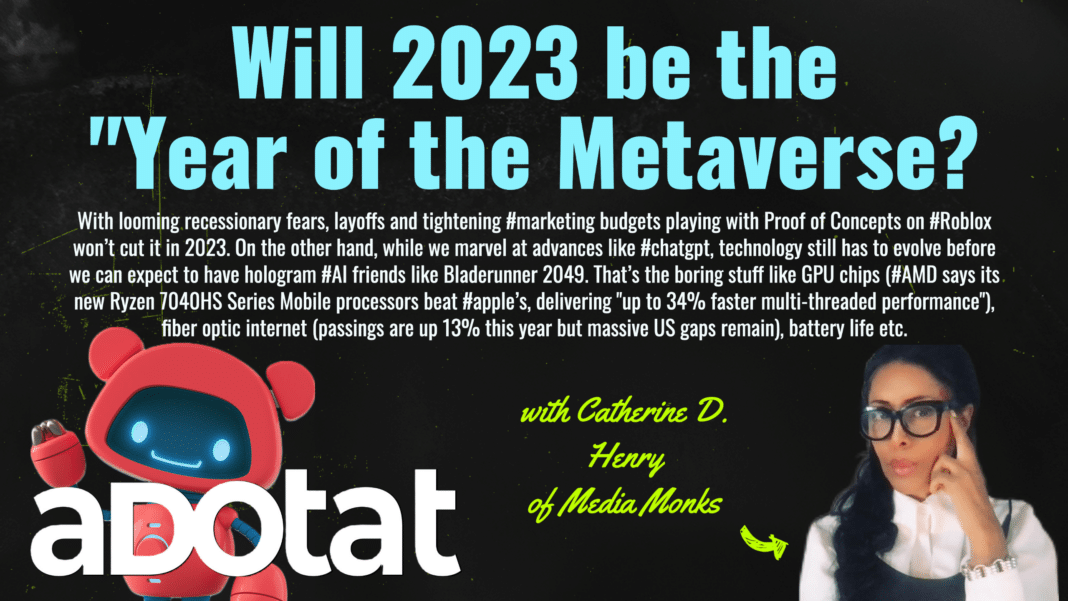At CES this year, we heard a lot about the metaverse.
But it wasn’t the bang we were expecting.
Instead, it was more of a whimper—a reminder that the future isn’t as fast as we’d like it to be.
The biggest news was that HTC Vive announced its next XR headset, the VIVE XR Elite. The mixed- and virtual-reality headset (MR/VR) includes a 110-degree FoV, 4K resolution, and a 90Hz refresh rate. It will be available in November for $1,200.
LG also announced smart TVs that presumably will be #NFT marketplaces—and Samsung made the same announcement in May 2022. We heard rumors that #amazon will also launch an NFT platform for #digitalmerch but without the TV at least for now—so it seems like this is still on the horizon for them (and maybe others).
Lastly, #Sony showcased a “proof of concept” metaverse it’s building with the #football club Manchester City—more excitingly, they promised an interactive physical and digital space called “The Sphere” which opens in September and will transform entertainment as we know it! This is something I first posted here in 2017: Yes
It’s not just that we’ll see the first commercial aircraft with a full-blown #VR experience (though I’m looking forward to that). And it’s not just that we’ll be able to walk into a store and buy an object, then use it to play games on our phones or tablets—we’ve been able to do that for years now.
With looming recessionary fears, layoffs and tightening #marketing budgets playing with Proof of Concepts on #Roblox won’t cut it in 2023. On the other hand, while we marvel at advances like #chatgpt, technology still has to evolve before we can expect to have hologram #AI friends like Bladerunner 2049. That’s the boring stuff like GPU chips (#AMD says its new Ryzen 7040HS Series Mobile processors beat #apple’s, delivering “up to 34% faster multi-threaded performance”), fiber optic internet (passings are up 13% this year but massive US gaps remain), battery life etc.
No, I think the real change is coming in how we interact with technology and each other. The physical world is becoming more like the digital one, and vice versa. We’ll have hologram AI friends, who can help us with shopping, managing our finances and even buying us gifts. We may even be able to have them help us with our travel plans! But what does this mean for your business?
First of all: planning for the future isn’t just about making sure your company has enough cash flow to survive during an economic downturn (though if you don’t do that first thing right, none of this will matter anyway). It’s also about thinking about how you can take advantage of new technologies and platforms while they’re still small enough not to be overwhelming—and then figuring out how those same will work in the future.
2023 will not be the year of the Metaverse, #VR hardware, nor of the NFT (thank heavens!).
Those are dependent on the further evolution of invisible architecture that enables digital worlds to run seamlessly. Content is secondary. The real focus should lie on the strategy to link Metaverse experiences to physical brick-and-mortar spaces or IRL events and access.
If you’re in the business of building content, you need to be thinking about how you can use your existing distribution channels to create new experiences for consumers. Think about how you can use your existing relationships with retailers, distributors, and other stakeholders in your vertical market to build out new revenue streams for your business.
As a marketer, you need to keep pace with the changing landscape of 3D volumetric platforms and communities if you’re going to succeed in a world where consumers are moving from 2D to 3D. That’s why it’s more important than ever for brands to have a long term sustainable strategy that fits their brand.










